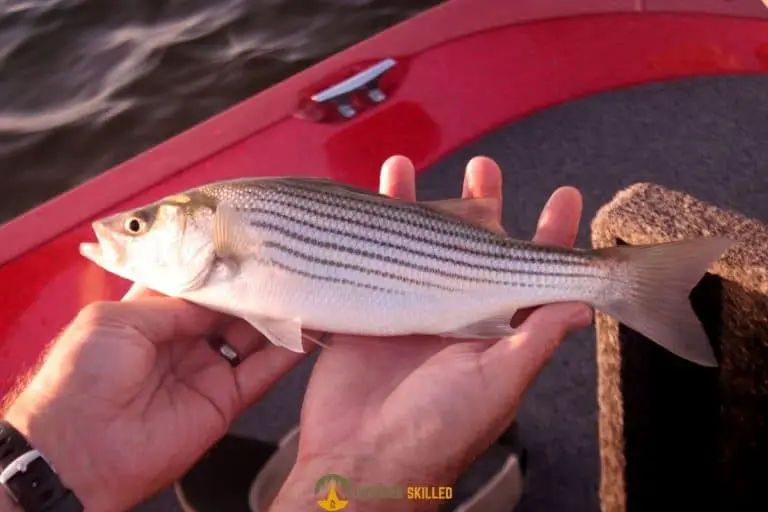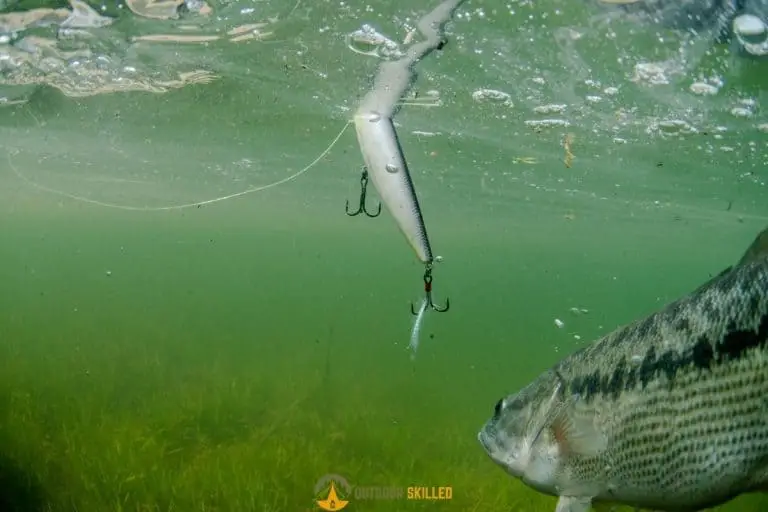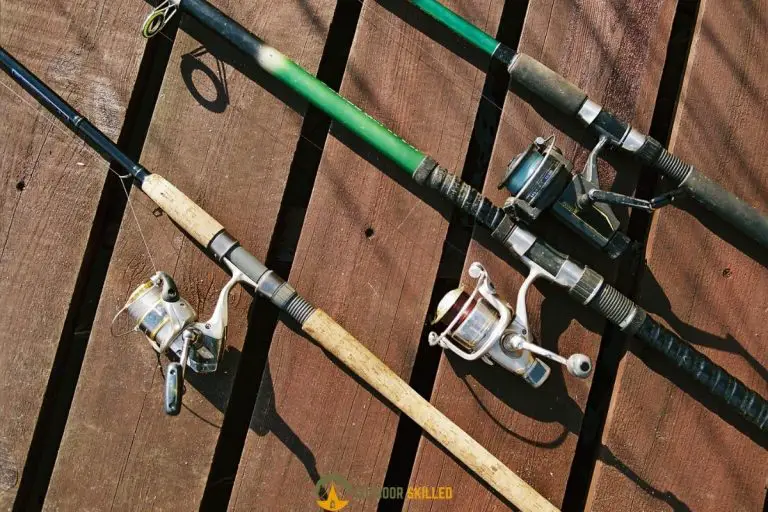The Best Spring Bass Lures – 5 Lures That Always Work Like a Charm
Spring can be the most challenging and the most rewarding season for bass fishing. That is because bass spawn in the spring which leads to a significant change in their behavior.
During the pre-spawn period, bass will be at their most vulnerable as they emerge from their inactive winter period to prepare for the spawning season.
When bass migrate from cold deep waters to shallow water during spring, they will begin to feed heavily and will readily strike at a well-presented lure.
That’s why choosing the right kind of lure can significantly increase your chances of landing your biggest bass of the season.
Since lures are available in a wide variety of colors and sizes, it can be difficult to choose the most suitable one. To help you make the best choice here’s a compilation of some of the top-rated spring bass fishing lures available on the market.
| Product Name | Lure Type | Weight |
|---|---|---|
| IMA Pin Jack 200 | Crankbait | 7.16 Ounces |
| Yo-Zuri 3DB | Jerkbait | 3.8 Ounces |
| Rapala Blue Fox Vibrax | Spinnerbait | 1.25 Ounces |
| Booyah Boo | Jig | 5.16 Ounces |
| Culprit Original Worms | Soft Plastic | 3.2 Ounces |
Table of Contents
List of the Best Spring Bass Lures in 2021
1. Best Overall – IMA Pin Jack 200 Crankbait

The top recommendation on our list is this crankbait from IMA. It’s ideal for spring bass fishing as it allows you to target them as they migrate from deep to shallow waters.
The Pin Jack 200 is designed to smoothly glide through the water without snagging whether you’re fishing in shallow cover or deep rock banks.
This crankbait creates a tight wobble and roll action that effectively grabs the attention of bass fish and gets them to bite. It also has excellent sinking capabilities and it can dive down to almost 7 feet.
It’s made from high-quality materials and it comes in multiple colors and patterns to suit different water conditions.
Pros Vs Cons
The Pros
- It can be used to fish in various depths
- It creates a tight action
- It has excellent sinking capabilities
- It’s made from high-quality materials
- It’s available in multiple colors and patterns
The Cons
- It’s not the best when it comes to casting accuracy.
Bottom Line
The IMA Pin Jack 200 Crankbait is the perfect choice for you if you’re looking for a versatile lure that allows you to target bass at various depths without snagging or losing its effectiveness.
You can learn more about crankbaits in this crankbait vs spinnerbait comparison.
2. Second Runner – Yo-Zuri 3DB Suspending Jerkbait

The Yo-Zuri 3DB Suspending Jerkbait is one of the most popular lures for spring bass fishing.
It’s designed with a realistic baitfish profile to mimic a variety of forage and it also creates a strong action that will surely attract bass fish and entice them to bite.
It’s made from durable materials to withstand the aggressive strikes of bass fish and it’s available in multiple colors and patterns to suit various water conditions.
It features two round bend black nickel treble hooks to ensure a solid hookset when a large bass strikes.
Pros Vs Cons
The Pros
- It’s made from highly durable materials
- It can effectively mimic baitfish
- It creates a strong action to attract bass
- It features two strong treble hooks
- It’s available in multiple colors and patterns
The Cons
- It’s slightly more expensive compared to other lures.
Bottom Line
The Yo-Zuri 3DB Suspending Jerkbait is the best choice for you if you’re looking for a life-like lure that’s guaranteed to grab the attention of bass during their spawning period by imitating various baitfish.
You can also learn more about Jerkbaits in this Jerkbait vs crankabit comparison.
3. Best On a Budget – Rapala Blue Fox Vibrax Spinnerbait

The Blue Vibrax lure from Rapala is one of the best spinnerbait lures. It’s a popular choice for many bass anglers as it offers excellent flash and action abilities at an affordable price.
It’s made from durable materials as it’s designed with a machined brass main body and stamped brass blades that are plated with silver or copper.
It features a strong treble hook and a free-turning brass gear that’s built-in to help prevent any line twists.
It creates a strong vibrating action that attracts bass fish and triggers them to bite.
It’s available in a range of colors and patterns to suit various water conditions. All color options have an iridescent shine that will enhance the lure’s visibility to bass fish.
Pros Vs Cons
The Pros
- It’s highly durable
- It’s available in a variety of colors and patterns
- It’s designed with a machined brass main body
- It features silver/copper-plated blades and a treble hook
- It creates a strong vibrating action that attracts bass
- It features a built-in turning gear to prevent line twist
The Cons
- It’s heavier than most spinnerbait lures
Bottom Line
The Rapala Blue Fox Vibrax Spinnerbait is the perfect choice for you if you’re looking for an affordable lure for targeting bass in the spring without having to sacrifice durability or performance.
4. Booyah Boo Jig

Another budget-friendly option is the Booyah Boo jig lure. It has many great qualities and comes at a very cheap price.
It has a flat bottom with an 18-degree rise that allows for more control when casting. Its body is coated with protective materials to enhance durability.
It’s perfect for targeting spring bass near heavy cover as it has a weed guard that allows the lure to easily move through brush piles and weed beds.
It features a black nickel wire single hook and flashy 60-strand ultra-fine silicone skirt which creates smooth action to grab the attention of bass.
It’s available in multiple colors and patterns to attract bass in different water conditions
Pros Vs Cons
The Pros
- It allows more control and accuracy when casting
- It’s made from durable materials covered with a protective coating
- It features a weed guard to reduce snagging
- It creates a smooth to grab the attention of bass
- It features a flashy 60-strand tail and a wire hook
- It’s available in multiple colors and patterns
The Cons
- The material of the hook is not the best for targeting larger bass.
Bottom Line
The Booyah Boo Jig lure is the perfect choice for you if you’re looking for a reliable and affordable lure that allows you to fish for bass near areas with heavy cover without facing any snags.
5. Culprit Original Plastic Worms

Culprit Original Plastic Worms are a must-have in every bass angler’s tackle box. It’s one of the best bass spring fishing lures on the market.
It’s is made from a soft plastic material and it’s designed with a tail that can move smoothly in the water at various depths creating a natural action that attracts bass fish.
It can be rigged using the Texas or Carolina method. The Texas rig method is recommended for fishing in shallow water areas with heavy cover, while the Carolina rig method is recommended for fishing in deep water areas.
The worms come in an 18-pack and they’re the perfect size for targeting bass. They’re available in a wide variety of unique colors and patterns to suit different water conditions.
Pros Vs Cons
The Pros
- It’s designed with a tail that creates a natural action
- It can be rigged using multiple methods
- It’s suitable for at various depth
- It’s the perfect size for targeting bass
- It is available in multiple colors and patterns
The Cons
- The soft plastic material is not very durable
Bottom line
The Culprit Original Plastic Worms are the best choice for you if you’re looking for a spring bass fishing lure that can be rigged to suit different water depths and conditions.
How to Choose the Best Lure for Spring Bass Fishing?

In general, bass prefers spinnerbaits, jigs, soft plastics, lipless crankbaits, and topwater lures.
In order to choose the best lures for spring fishing, you need to keep in mind that bass typically prefers lures that are designed to look similar to what they naturally eat.
It’s good to go for with moving parts that can mimic the movement of real baitfish to get the bass’s attention.
Lures that produce noises and vibrations are also effective in triggering a response in the bass to get them to bite, particularly when fishing close to the nests where they’re spawning.
You also need to make sure to choose lures in colors that are within the range of colors that bass fish can see.
How to Catch Bass Fish During Springtime?
Types of Bass
There are two common types of bass fish which are the largemouth bass and smallmouth bass. Both types have distinctive features that help set them apart.
The largemouth bass is green-colored. It has a long jawline that extends past its eyes and horizontal stripes all over its body. Its dorsal fin has a break in it making it look like two separate fins.
This type of bass tends to prefer slow currents and warm water. It’s not picky when it comes to its diet and will generally eat anything.
In contrast, the smallmouth bass is brown colored. It has a small jawline that doesn’t extend past its eyes and vertical stripes all over its body. Its dorsal fin doesn’t have any breaks.
This type of bass tends to prefer fast currents and cold water. It’s pickier when it comes to its dies because of how small its mouth is.
Both types of bass have fairly sharp teeth even though you may not be able to see them because their teeth are small and facing inwards.
Bass teeth are needle-like and they feel almost like sandpaper to touch. However, they are not strong enough to cause any significant damage when handling them.
Bass will mainly rely on their teeth to help them catch and keep a strong grip on their prey before they kill it inside their throats. While different species of bass might have a preference for different kinds of prey, they all rely on their teeth for that same purpose.
Where to Locate Bass in The Spring?
Generally, largemouth bass prefers warm water and slower currents, so it’s found near the south while smallmouth bass prefers cold water and faster currents, so it’s found more towards the north.
However, during the pre-spawn period, bass will migrate from their wintering areas in deep waters to shallow areas where they will lay their eggs.
So, the key to being successful when targeting bass during spring is learning their migration pattern whether they are in a lake, pond, river, or creek.
When bass makes their way to shallow water, they will linger in areas along the ridges, especially in the spots where flat shallows meet steep drop-offs.
They can also be found around rocky areas and near the edges of heavy cover such as logs, stumps, brush piles, and weed beds.
When to Fish for Bass in The spring?
Spawning season for bass doesn’t have a set time each year however, it often starts late May or early June depending on the temperature.
Water temperature is one of the most important factors in determining bass behavior and feeding activity. So, the best time to fish for bass in spring would be when the temperature is between 50 and 70 degrees.
What Is the Best Gear for Bass Fishing in The Spring?
You generally need heavy gear when fishing for bass because they are large in size and can put up quite a fight.
You need to have a strong fishing rod, reel, line, and hooks to handle the aggressive nature of bass.
To target bass during spring, it’s recommended to use a medium-heavy powered fishing rod with heavy action that’s 6’7” to 7’8” feet in length.
When it comes to the reel, it’s recommended to go for a baitcasting reel with a 6.1:1 gear ratio.
You can spool the reel with a 12-20-pound fluorocarbon line or an 8-pound braided line
It’s also recommended to use hook sizes between 4 to 6/0 larger hooks. That’s because hooks that are too small might bend or break in the bass’ mouth if they put up a fight.
If you are going fishing in the winter or in the colder weather in general, you should definitely check out my guide to cold water bass fishing here.
How to Properly Handle Bass Fish?
Handling a bass fish after landing is not as easy as you might think, so it’s important to learn the proper methods of holding the fish and what to avoid.
When you’re holding a bass fish, you need to avoid removing the fish’s slime coat That is because a fish’s slime coat acts as a barrier to protect the fish from infection and diseases. It also helps prevent the loss of essential bodily fluids.
You also need to protect the fish’s jaw. That is because putting too much pressure on a fish’s jaw can affect its ability to catch prey when you release it back into the water.
There are some commonly practiced methods you could use to help you properly hold a; bass fish without causing it harm. Let’s break down these methods in more detail
Vertical
- This is the safest method to hold a bass fish.
- You need to hold the bass vertically with its mouth facing upwards and its tail pointing downwards. This will relieve any pressure on the bass’ jaw from the weight of its body.
- You need to make sure to keep your thumb placed inside the fish’s mouth and keep a firm hold of its bottom lip. You also need to press the rest of your fingers against the outside of the fish’s lip to avoid dropping the fish.
Horizontal
- This method is more visually appealing, especially for taking a “prized catch” picture.
- You can get your grip right by following the same steps for the vertical hold, then you need to use your other hand to gently support the body of the fish right behind its anal fin.
- Make sure to keep the fish’s mouth in a position that is slightly higher than its body to reduce some of the pressure on the jaw.
Angled
- This method is more ideal for smaller bass
- It could cause some damage to the jaw of a larger bass because holding the fish at too much of an angle (greater than 10 degrees) can put too much pressure on the bass’ jaw.
Frequently Asked Questions
What to Do If You Get Bitten by A Bass Fish?
If you get bitten by bass fish, you need to apply pressure on the wound to stop the bleeding then rinse it with fresh water. Make sure to apply antiseptic and cover the wound with clean bandages to prevent any infection. If the bleeding doesn’t stop, it’s recommended to call emergency services as the injury would be more serious and you may require stitches
How to Remove Your Hook from A Bass Fish?
In order to remove your hook from a bass fish, you first need to reel in your catch until you can grab it with your hand. Then you need to grip the eye of the hook using pliers and roll it towards the hook’s point. When your hook starts to yank the fish’s mouth, twist the hook’s point and carefully pull it out of the bass’ lip.




![Why Do Bass Have Red Lips? [Explained Simply]](https://outdoorskilled.com/wp-content/uploads/2022/06/bass-fish-2-768x512.jpg)
![Why Are Bass Boats So Fast? [Simply Explained]](https://outdoorskilled.com/wp-content/uploads/2021/11/bass-boat-speeding-768x512.jpeg)

![The 5 Best Bass Boats For The Money – After Testing Dozens! [Updated]](https://outdoorskilled.com/wp-content/uploads/2021/08/bass-fishing-boats-768x512.jpg)
